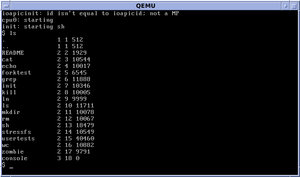xv6
|
xv6 startup, and using the "ls" command | |
| Developer | MIT |
|---|---|
| Written in | C |
| OS family | Unix-like |
| Source model | Open source |
| Latest release | rev8 / August 29, 2014 |
| Available in | English |
| Platforms | multiprocessor Intel x86 |
| Kernel type | Monolithic |
| Default user interface | Command-line interface |
| License | MIT license |
| Official website | http://pdos.csail.mit.edu/6.828/2014/xv6.html |
xv6 is a modern reimplementation of Sixth Edition Unix in ANSI C for multiprocessor x86 systems. It is used for pedagogical purposes in MIT's Operating Systems Engineering (6.828) course.
Purpose
Unlike Linux or BSD, xv6 is simple enough to cover in a semester, yet still contains the important concepts and organization of Unix.[1] Rather than study the original V6 code, the course uses xv6 since PDP-11 machines are not widely available and the original operating system was written in archaic pre-ANSI C.[1]
Self-documentation
One feature of the Makefile for xv6 is the option to produce a PDF of the entire source code listing in a readable format. The entire printout is only 97 pages, including cross references.[2] This is reminiscent of the original V6 source code, which was published in a similar form in Lions' Commentary on UNIX 6th Edition, with Source Code.
Educational use
xv6 has also been used in operating systems courses at University of Illinois at Chicago,[3] Rutgers University,[4] Northeastern University,[5] Yale University,[6] Columbia University,[7] Ben-Gurion University,[8] Johns Hopkins University,[9] Tsinghua University,[10] the University of Wisconsin-Madison,[11] the University of Utah,[12] [13] IIT Madras in India, the Linnaeus University[14] in Sweden, the University of Otago[15] in New Zealand, the National University of Córdoba[16] and the National University of Río Cuarto,[17] in Argentina, the Università degli Studi di Palermo[18] in Italy and the Federal University of Minas Gerais[19] in Brazil.
References
- 1 2 "Xv6, a simple Unix-like teaching operating system". Retrieved 2014-09-22.
- ↑ "xv6 source listing" (pdf). Retrieved 2014-09-22.
- ↑ "CS385 - Operating Systems Concepts and Design". Retrieved 2015-03-18.
- ↑ "01:198:416: Operating Systems Design". Retrieved 2010-02-05.
- ↑ "CS 3650: Computer Systems, Fall 2014". Retrieved 2014-12-09.
- ↑ "CS422/522: Operating Systems, Spring 2010 — Overview". Retrieved 2010-02-05.
- ↑ "COMS W4118: Operating Systems I, Fall 2013". Retrieved 2013-09-09.
- ↑ "Operating Systems - 2012/Spring - Main". Retrieved 2012-03-26.
- ↑ "600.318/418: Operating Systems". Retrieved 2015-11-07.
- ↑ "FrontPage - OS Teaching Wiki". Retrieved 2010-03-18.
- ↑ "CS-537: Introduction to Operating Systems". Retrieved 2011-11-04.
- ↑ "CS 6460: Operating Systems". Retrieved 2014-01-20.
- ↑ "Embedded in Academia : Xv6". Retrieved 2014-04-08.
- ↑ "1DV201: Operating system". Retrieved 2013-03-14.
- ↑ "COSC440: Advanced Operating system". Retrieved 2015-07-14.
- ↑ "SistOp14: Operating Systems". Retrieved 2015-08-06.
- ↑ "Operating Systems". Retrieved 2015-08-06.
- ↑ "Sistemi Operativi". Retrieved 2015-10-18.
- ↑ "DCC605: Sistemas Operacionais". Retrieved 2015-11-16.
External links
- xv6 Home page
- xv6 source code
- Printable version of the xv6 source code, rev8.
- xv6: a simple, Unix-like teaching operating system., xv6 book rev8.
- Operating Systems Engineering (6.828)
